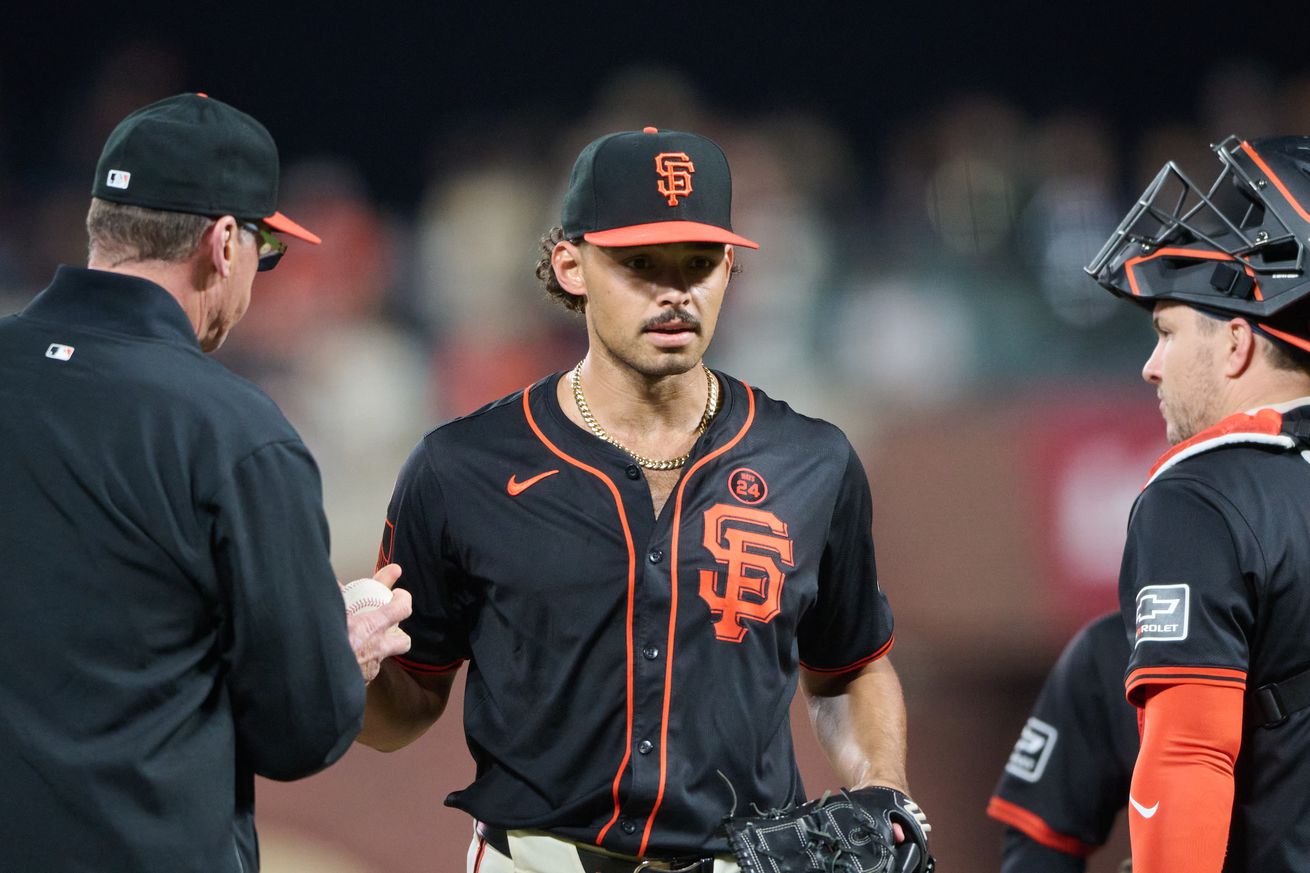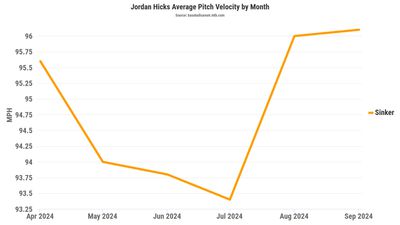
Hicks kicked off his career as a starting pitcher with an impressive month that got everyone super duper excited before devolving into an ineffectual ball of exhaustion by July…but there’s always next year.
2024 stats: 29 G (20 GS), 109.2 IP, 4.10 ERA (4.91 xERA), 1.450 WHIP, 7.9 K/9, 3.9 BB/9, 50.8 GB%
There was a time when signing Jordan Hicks looked like a stroke of genius. A time, albeit long ago, that came to a head on a day: April 27th, 2024.
The San Francisco Giants had dropped the second game of a three game series against the Pirates, losing 4-3 in 10 innings to sink them two games below .500. Their lineup mustered a single run, just enough to force extra innings. Matt Chapman and his sub-.700 OPS had yet to shake the slump that dogged him from Toronto. Jung Hoo Lee refused to miss the baseball, but the freakish contact lacked the pop it had in Korea. Jorge Soler launched a 2-run shot, but it was when they were down by three in the 10th.
Too little too late and not nearly often enough was the vibe.
But on April 27th, the Giants had a chance to win a game because of Jordan Hicks. The right-hander was not only present and playable—unlike Blake Snell or Robbie Ray—but he was delivering spectacularly on his end of a 4-year, $44 million dollar deal.
In his sixth career start, Hicks allowed a run over 6+ innings pitched — a run that crossed the plate thanks to a botched play at second, a walk and a sacrifice fly that all went down as he watched from the dugout. His performance was a duet of two pitches. A mid-90s sinker established the zone, attacked the plate to avoid deep counts, and sped up hitters, while a splitter flared out and banana-ed, baiting errant and ill-timed swings. Both pitches nested in the other. Even missed locations — sinkers over the heart of the plate, floating beach ball splitters — were effective because of Hicks’s convincing arm action, his casual and kick-y delivery. 8 of the 9 strikeouts (a career high) came on the seams of the offspeed. 6 of those 8 went down swinging.
Hicks entered that game with a 1.61 ERA and left it with a 1.59 ERA, the lowest on the staff at that point by a fair margin. His ground-ball rate teased 60%, his somewhat elevated walk-rate minimized by a low hit rate. Over those 6 starts and 34 innings, he boasted a 0.91 WHIP, with hitters batting .179 against him with a .225 average on balls in play. A 34.4% Hard-Hit was the lowest among Giants starters by ten points.
Jordan Hicks has been on absolute in his first three starts as a Giant
⚾️ 2-0 / 18 IP
⚾️ 1.00 ERA
⚾️ 0.83 WHIP
⚾️ 13 Ks/2 WalksSeems like this guy can be a starter pic.twitter.com/bS3yypB8qv
— KNBR (@KNBR) April 11, 2024
That outing in late April was the end of an incredibly impressive first month as a debut starter … it was also the end of Hicks’s dominance. His third quality start in a month and his last. Hicks never pitched into the 7th again, never again completing even six innings.
May wasn’t by any means awful, just a sharp and noticeable decline from the early highs. There were good games, but Hicks’s appearances started to feel different. His efficiency went down. At-bats and innings seemed to get harder to close out. His K and BB-rates stayed somewhat consistent, but he started to get punished more for missed locations. The Hard-Hit rate jumped to 47%. Barrels got under his offerings more. Opponents started seeking out the sinker. They timed themselves up better with the splitter, and launched just a couple, but consequential, sweepers.
In his first 8 games, Hicks allowed just one homer before giving up five over his last four games in May. Some of this could be explained by the opponents he faced: the Phillies, Doogers, Mets, Yankees, Rockies…in Denver. The stress level had kicked up a notch, the margin for error whittled to the width of a seam, all with his innings total continuing to grow.
Aaron Judge (19)
Opponent: San Francisco Giants
Pitcher: Jordan Hicks
Date: 5/31/24Exit Velocity: 104.4mph
Distance: 394ft
Launch Angle: 27° pic.twitter.com/4NtUpTQnpr— Yankees Home Runs (@NYY_HR) June 1, 2024
Workload was the major concern from the very beginning. Innings pitched would be the stat that dictated Hicks’s conversion season. Even so, it’s still shocking how quickly numbers can cumulate. By the end of May, Hicks had pretty much matched his career average for innings pitched in a season. Mid-June he had matched his career high of 77.2 innings, a mark set in his rookie season in 2018.
His last win came on May 19th, his tenth start of the season; his last decent start on June 17th against Chicago (5 IP, 4 H, 0 R, 4 BB, 4 K); his last start period came on July 23rd, and he couldn’t get out of the 4th. That 4-run, 5-walk thrashing in LA had been preceded by a month of similar beatings. The once promising premier season as a starter ended in an uncontrollable tumble. Over his last five starts, he allowed 20 earned runs over 22 innings pitched. He walked 13 batters, was served four losses, then watched the duration of the season from the relative comforts and obscurities of the bullpen and injured list.
95.6 to 94 — the Hicks catastrophe, the devolution after the evolution, could be explained by the difference between those two numbers. 1.6 MPH: the average drop in Hicks’s sinker velocity from April to May. Those two clicks on the radar gun were only recovered until after his end of the year reliever relegation.

Hicks and the coaching staff anticipated a significant adjustment on his fastball would have to be made to facilitate his transition from high-velocity reliever to starter. His average sinker velocity in 2023 teased triple-digits, a pace that would not be sustainable as a member of the rotation. Out of the gates, Hicks shaved around four beats off his primary pitch, and it’s clear now that they underestimated the toll a month at that velocity would take on his arm. In order to not completely flare out before Memorial Day, he had to pump the brakes again. Coupled with all the other mental and physical adjustments required of him, the lost zip had an extreme cost. In that first month, hitters hit .238 (.236 xBA) facing Hicks’s sinker and slugged .333 (.328 xSLG). Impressive stats that went the way of the Hindenburg in the following months: Opponents hit .313 (.325) and .448 (.542) in May, and .462 (.437) and .692 (.709) in June.

That dip in velocity trickled down to effect his split-finger as well. A slower velo means less of a discrepancy between the offspeed. Though opponents’ numbers against the splitter improved nominally, they weren’t nearly as damning as the numbers against the sinker. It remained effective, with some exceptions here and there, at limiting consequential contact (.287 SLG) as well as missing bats entirely (40.8 Whiff%).
Despite the splitter’s successes, Hicks’s usage of the pitch as his secondary weapon was usurped by his sweeper as the season progressed. In April, Hicks threw the offspeed 22% of the time. In July, the usage had dropped to 9%. The historical perception is that it puts undue stress on the arm to deliver properly — as if the pitcher ends up throwing his elbow rather than the ball in his hand. Maybe that’s why the usage went down, or at least a small part of the why. I imagine its finicky nature didn’t help either. The split is a feel pitch, “volatile” according to Hicks, and needs to be thrown with a certain level of conviction given it’s designed to play off a fastball and/or drop out of the zone. Confidence in it probably frayed given his overall struggles. Not surprisingly since he threw less than 20 of them in 2023, and not a single one after June of that year. The splitter was a necessary addition, intergrated into his arsenal to help face the same line-up multiple times in a game. The pitch definitely excited for a time, dippin’, dartin’ and dyin’ like that evening on April 27th, but at a certain point in the summer, Hicks had to revert to survival mode. Exhaustion leads to missed locations which leads to unfavorable counts which leads to high-stress situations which leads to costly and compounding mistakes. This lack of control probably played into his desire to throw something he was more comfortable with, which ultimately kicked him off on a vicious downward spiral of predictability then distress, predictability then distress.
How does Jordan Hicks react to his first save of the season?
“Hi, mom” pic.twitter.com/lzqzoNf9Ao
— SFGiants (@SFGiants) August 20, 2024
But Jordan Hicks’s transition to a viable starting pitcher was always going to take longer than a year. Building up endurance is a process that funnily enough, needs to be endured — a sensation acutely felt by fans during some of those later starts. So I’m far from despondent about Hicks. Last season served its purpose: strength building, fact-finding. He’s got the stuff and now a better understanding of how to mold them into an effective mix that not only takes advantage of each pitch shape individually, but how they play off each other. “Pitching,” as opposed to “throwing” — this is the difference in approach between a starter and reliever. Velocity and spin rate and break get the fire flame emojis and all that, but controlling and being able to locate a “low velo” pitch is better and more sustainable over the long run. Hicks could get away with a lot more when his sinker clocked in at 100 MPH.
Even though he’s a Farhan signing, even after the rough end to the year, I can’t imagine Buster and the new Giants’ brass are “out” on Hicks. The transition to starter had its considerable downs, but the downs were forseeable, almost expected to a certain degree, and in my mind, aren’t enough to deter them, or the coaching staff, from seeing this thing through. You better believe Hicks is still game. He’s young-ish, athletic, eager — the 4-year, $44 million deal could still very much be a bargain. The expectations will be tempered though. He’ll hopefully improve on his 109 innings pitched (98 as a starter), but getting a full season’s worth out of him feels unlikely, nor do they want to feel reliant on him pitching a full inning load. After the shot-down-plane trajectory of 2024, expect management to come up with a way to extend Hicks’s airtime in 2025 with more scheduled rests between starts (aided by a six man rotation), or leaning into his hybridity as a starter/reliever.